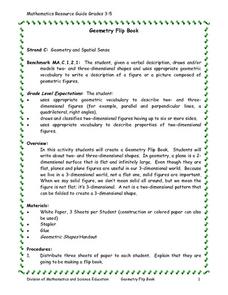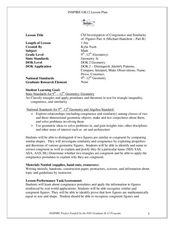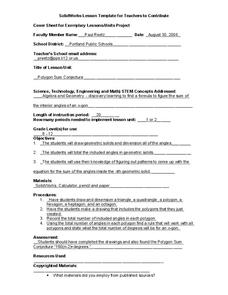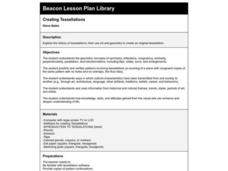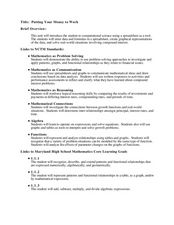Curated OER
Geometry Gymnastics
Students identify shapes and manipulate 2 and 3 dimensional objects. They view objects from different perspectives and review relative positions (near, far, between). They sing a shape song.
Curated OER
Tar Beach Quilt
Pupils cut and design a pretend beach after reading Faith Ringold's "Tar Beach" book.
Curated OER
Geometry Flip Book
Students investigate the concepts of geometry that can be grouped into a flip book that can be used for teaching and review purposes. They define the differences between two and three dimensional figures. Also polygons are reviewed and...
Curated OER
Putting It All Together
Students complete activities to learn about the shapes and their vertices. In this shape recognition lesson, students discover the rule linking the number of sides with the number of vertices for shapes. Students categorize...
Curated OER
Rhythm and Movement
Third graders identify the rhythms and movements found in different works of art. In this visual arts lesson, 3rd graders view samples of art work and use hand gestures to demonstrate the movement of the image. Students pick one art...
Curated OER
Investigating Nets and Polyhedra
Fifth graders create a net for a given polyhedron. They determine the corresponding polyhedron for a given net. Students investigate several polyhedra (cube, tetrahedron, and one of their choosing) and their corresponding nets. They...
Curated OER
Exploring the Properties of Rectangular Prisms.
Students define properties of rectangular prisms. For this geometry lesson, students identify the relationship between two and three dimensional objects. They use Cabri technology to graph their figures.
Curated OER
Exploring Properties of Rectangular Prisms
Students explore the properties of rectangular prisms. In this geometry instructional activity, students identify properties of two and three dimensional shapes. They use Cabri technology to create polygons and solve problems.
Curated OER
CSI Investigation of Congruence and Similarity
Students differentiate between similarity and congruence using polygons. In this geometry lesson, students label triangles based on their properties. They find missing sides and angles using the interior sum theorem.
Curated OER
Parallel-o-Home
Learners investigate the usage of parallel and perpendicular shapes in the real world. For this geometry lesson, students investigate shapes for properties that are related to the real world. They relate all the properties of shape tot...
Curated OER
Polygon Sum Conjecture
Students calculate the sum of the angles of a polygon. In this geometry lesson plan, students use the interior angle formula of polygon based on the number of sides of the polygon. They identify the missing angle using algebra.
Curated OER
Creating Tessellations
Third graders explore the history of tessellations; then use art and geometry to create an original tessellation.
Curated OER
Logic
Middle schoolers solve problems using reasoning techniques, identify the validity or non-validity of problems and use deductive reasoning for problem resolution.
Curated OER
Ojibwa Sewn Bead Designs
Learners research the Ojibwa beading design. They create their own beading necklace or bracelet.
Curated OER
Prairie Activity: Prairie Quilt
Pupils investigate prairie life in the 19th century. They research quilts and prairie images online, take a photo of an object related to prairie life, transfer the image onto fabric, and create a class quilt.
Curated OER
What's The Point?
Learners solve word problems using the correct math symbols. In this algebra lesson, students use the TI calculator to graph their equation and analyze it. They find the line of regression and use to draw conclusion.
Curated OER
Putting Your Money to Work
Students create a collect data on expenses. In this algebra lesson, students create a spreadsheet to solve scientific equations. They incorporate math, science and technology in this lesson.
Curated OER
Africa: Beauty is in the Eye of the Beholder
Students will create a poster showing how two different cultures strive for beauty. This lesson combines art and social studies in a meaningful way.
Curated OER
Learning about Shapes with Tangrams and the Net
Learners use tangrams, student literature, and Websites to explore shapes.
Curated OER
Governor's Garden
Students review types of polygons and list several examples of each. They assume the role of a landscape artist interviewing for a job. They create sketches of their plans for six polygonal gardens and write an expository paragraph...
Curated OER
Using Nets to Find Surface Area
Eighth graders explore three-dimensional objects (prisms, pyramids, cylinders and cones) to draw nets. They use the understanding of drawing nets to find the surface area of pyramids and cylinders.
Curated OER
Tessellations Lesson
Fifth graders demonstrate their understanding of tessellations by watching a teacher prepared Powerpoint presentation and completing an activity. The students work independently to identify tessellations.
Curated OER
Constructing Tangrams
Sixth graders are introduced to how geometry and algebra are related. In groups, they graph various points on a coordinate plane and write the ordered pair for each quadrant. Using this information, they create their own tangrams to...
Other popular searches
- Extending Geometric Patterns
- Geometric Patterns 3rd Grade
- Geometric Patterns in Math
- Geometric Patterns Rules
- Rules for Geometric Patterns
- Simple Geometric Patterns
- Math Patterns Geometric Shapes
- Geometric Patterns Handouts
- Template Geometric Patterns
- Geometric Patterns Worksheet
- Numeric and Geometric Patterns
- Number and Geometric Patterns




